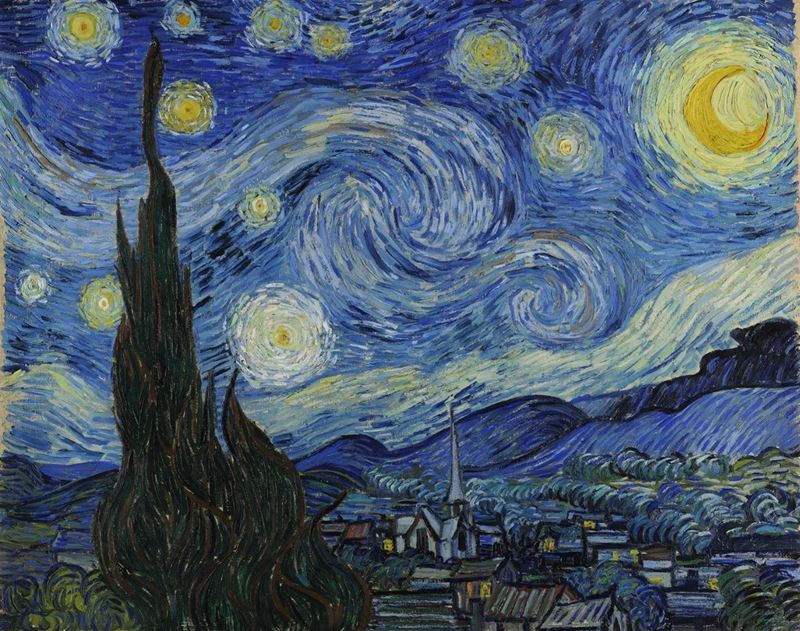The Starry Night - Vincent van Gogh
The Starry Night, 1889, Oil on canvas, 73.7 x 92.1 cm, Museum of Modern Art, New York, USA.
In September 1888, Vincent van Gogh moved to the city of Arles in southern France. Van Gogh moved to the Yellow House was a painter friend Gauguin had arrived. They lived together for about two months and worked together. In December, there was an argument between Van Gogh and Gauguin. He had a nervous breakdown after Van Gogh cut his left ear off. Gauguin had left Arles. Van Gogh was taken to hospital. He was discharged on January 1889 after several weeks of treatment. In February, he had to return to the hospital with the relapse of his disease. Van Gogh, who accepted his aggravation of the situation, voluntarily lay in Saint Rémytas mental hospital of Saint-Paul-de-Mausole, which was at a distance of 25 kilometers from Arles, in May. About a year later, he was allowed to paint outside under the supervision of the ward responsible. During this period, he usually made landscape paintings and was totally focused on nature. He used the cypress tree, the repeating new subject, in almost all of his paintings in this period. He discovered real motion in his paintings; it was seen that he gave importance to rhythm and movement rather than color. The finely delineated features, up to the final boundary, stood out. There were complex scans formed by intertwined, wavy rounds and short, sharp brush touches. The sky was fusing the earth as a whole. He used these features in his masterpiece "The Starry Night", one of the most important and unusual paintings he made in June. This painting was one of the few paints of Van Gogh's direct imagination of nature that did not originate from the depiction of nature.
The picture shows a wide border between the sky and the ground. This boundary created a large light band above the horizon created by diagonal brush strokes. The actual event in the picture was in the sky and it seemed like a universal event was taking place here. Everything was in case of circular motion. Only ten bright stars surrounded by light yellow parts were not in a circular motion. The dark blue sky had joined this circular movement. The massive intertwined spiral was moving inwardly into the nebula. At the top right there was an unreal orange moon. The moon united with the sun and surrounded the Moon.
Van Gogh depicted what he did not deviate from the reality he lived on earth. The landscape in front of him was around the mental hospital. The village near the town of Saint Rémy was seen under the mountains and cypresses. With the elements he had chosen on the earth, he made a situation against the sky. The silent town, reminiscent of the north depicted with short, cut brush touches, contrasted with the rounded forms in the sky. In the quadrangular forms of the windows of the houses, the little yellow lights influenced the contrast with the stars. The peaked bell tower reminiscent of the northern churches, the mountains rising up to the horizon, the dark cypress tree that was like a dark flame was rising to the sky. Verticality dominated the earth, forming an opposite form with the spiral nebulae in the sky.
"The Starry Night" was a masterpiece by Van Gogh as an effort to tell the eternity of nature.
Products designed for "The Starry Night"
Bibliography;
Walther, I.F., (2005). Van Gogh, Birinci Basım, Taschen/Remzi Kitabevi, İstanbul.
Altuna, S., (2013). Ünlü Ressamlar Hayatları ve Eserleri, Birinci Baskı, Hayalperest Yayınevi, İstanbul.
Eroğlu, Ö., (2014). Üç Postempresyonist Ruh Cézanne-Van Gogh-Gauguin, Birinci Baskı, Tekhne Yayınlar, İstanbul.
Bell, J., (2009). Sanatın Yeni Tarihi, Birinci Baskı, NTV Yayınları, İstanbul.
Spence, D., (2015). Büyük Ressamlar Van Gogh, Üçüncü Baskı, Beta Yayınları, İstanbul.













